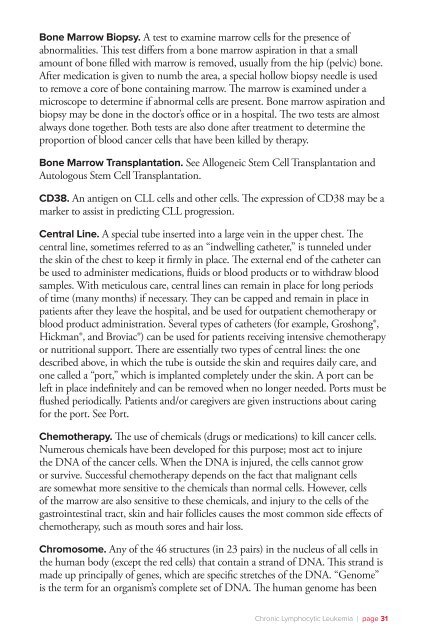Chronic Lymphocytic Leukemia - The Leukemia & Lymphoma Society
Chronic Lymphocytic Leukemia - The Leukemia & Lymphoma Society
Chronic Lymphocytic Leukemia - The Leukemia & Lymphoma Society
You also want an ePaper? Increase the reach of your titles
YUMPU automatically turns print PDFs into web optimized ePapers that Google loves.
Bone Marrow Biopsy. A test to examine marrow cells for the presence of<br />
abnormalities. This test differs from a bone marrow aspiration in that a small<br />
amount of bone filled with marrow is removed, usually from the hip (pelvic) bone.<br />
After medication is given to numb the area, a special hollow biopsy needle is used<br />
to remove a core of bone containing marrow. <strong>The</strong> marrow is examined under a<br />
microscope to determine if abnormal cells are present. Bone marrow aspiration and<br />
biopsy may be done in the doctor’s office or in a hospital. <strong>The</strong> two tests are almost<br />
always done together. Both tests are also done after treatment to determine the<br />
proportion of blood cancer cells that have been killed by therapy.<br />
Bone Marrow Transplantation. See Allogeneic Stem Cell Transplantation and<br />
Autologous Stem Cell Transplantation.<br />
CD38. An antigen on CLL cells and other cells. <strong>The</strong> expression of CD38 may be a<br />
marker to assist in predicting CLL progression.<br />
Central Line. A special tube inserted into a large vein in the upper chest. <strong>The</strong><br />
central line, sometimes referred to as an “indwelling catheter,” is tunneled under<br />
the skin of the chest to keep it firmly in place. <strong>The</strong> external end of the catheter can<br />
be used to administer medications, fluids or blood products or to withdraw blood<br />
samples. With meticulous care, central lines can remain in place for long periods<br />
of time (many months) if necessary. <strong>The</strong>y can be capped and remain in place in<br />
patients after they leave the hospital, and be used for outpatient chemotherapy or<br />
blood product administration. Several types of catheters (for example, Groshong®,<br />
Hickman®, and Broviac®) can be used for patients receiving intensive chemotherapy<br />
or nutritional support. <strong>The</strong>re are essentially two types of central lines: the one<br />
described above, in which the tube is outside the skin and requires daily care, and<br />
one called a “port,” which is implanted completely under the skin. A port can be<br />
left in place indefinitely and can be removed when no longer needed. Ports must be<br />
flushed periodically. Patients and/or caregivers are given instructions about caring<br />
for the port. See Port.<br />
Chemotherapy. <strong>The</strong> use of chemicals (drugs or medications) to kill cancer cells.<br />
Numerous chemicals have been developed for this purpose; most act to injure<br />
the DNA of the cancer cells. When the DNA is injured, the cells cannot grow<br />
or survive. Successful chemotherapy depends on the fact that malignant cells<br />
are somewhat more sensitive to the chemicals than normal cells. However, cells<br />
of the marrow are also sensitive to these chemicals, and injury to the cells of the<br />
gastrointestinal tract, skin and hair follicles causes the most common side effects of<br />
chemotherapy, such as mouth sores and hair loss.<br />
Chromosome. Any of the 46 structures (in 23 pairs) in the nucleus of all cells in<br />
the human body (except the red cells) that contain a strand of DNA. This strand is<br />
made up principally of genes, which are specific stretches of the DNA. “Genome”<br />
is the term for an organism’s complete set of DNA. <strong>The</strong> human genome has been<br />
<strong>Chronic</strong> <strong>Lymphocytic</strong> <strong>Leukemia</strong> I page 31

















